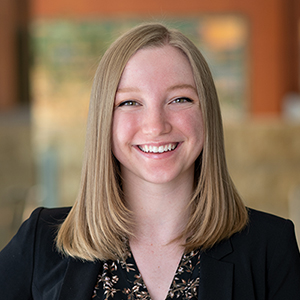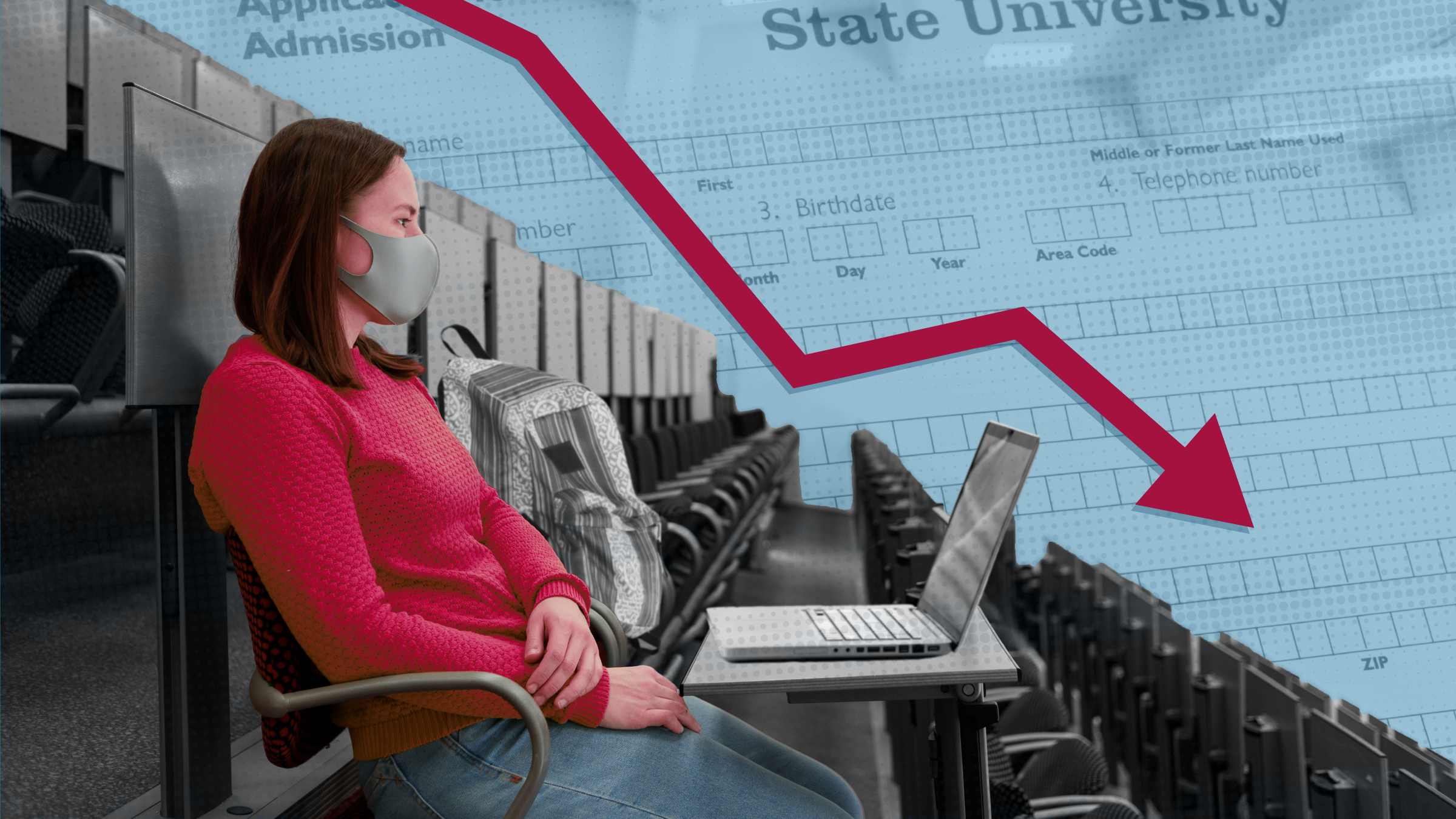Recessions typically bode well for colleges and universities. When the economy slows, people often turn to higher education to help improve their employment prospects in a soured job market, leading to increased enrollments at post-secondary institutions.
However, the economic upheaval caused by the COVID-19 pandemic has had an opposite effect. Enrollments have continued a downward trend set in place almost a decade earlier; and in some cases, the pace of decline has accelerated.
On the surface, the pandemic appears to have had little influence on the downward trajectory of enrollments overall in the Ninth District. Enrollments declined at an annual rate of roughly 2 percent for the last seven years in the district, a trend that has held mostly steady during the pandemic. According to National Student Clearinghouse data, total enrollments in the Ninth District are now 5 percent below fall 2019 levels.
Data show that some states faced sharper declines in enrollments than others during the last two years. Wisconsin, Montana, and South Dakota saw stronger enrollment declines in the first year of the pandemic, leading to a drop of around 5 percent in the fall 2020 semester compared with pre-pandemic levels (Chart 1).
In contrast, Minnesota and North Dakota saw overall enrollment declines slow during the pandemic compared with the rate of prior years.
Enrollment trends have also varied across types of post-secondary institutions in the Ninth District. Public two-year colleges have been hit the hardest over the last decade, and enrollment fell even further during the pandemic, declining over 10 percent in 2021 from fall 2019 levels across Ninth District states (Chart 2).
Enrollments at Ninth District private and public four-year colleges have not scraped by unscathed either. Private college enrollment is currently 7 percent below pre-pandemic levels despite fending off major declines during the first year of the pandemic. Public four-year colleges are coping somewhat better, with just a 4 percent decline overall, but many are still feeling the strains of falling demand for post-secondary education.
Behind some of these enrollment declines are shifting demographics, both before and during the pandemic. Across much of the district, there are simply fewer college-age adults in the population than there were in previous decades.
“In Montana, we had a decline totaling about one thousand high school graduates a year over the last decade,” explained Joe Thiel, director of Academic Policy and Research at the Montana University System. “The state just has had an aging population overall.”
In addition to the smaller college-age population, Ninth District high school graduation rates declined in the last two years according to data from Kids Count, further limiting the number of people able to apply to colleges during the pandemic.
These trends do not appear to be letting up anytime soon. Of future concern for post-secondary institutions is a sharp drop in birth rates that began after 2008. This drop has created what is known among higher education professionals as the enrollment cliff: an even more severe enrollment decline predicted to begin around 2025 when this smaller cohort becomes college age.
The Great Interruption
The ongoing public health crisis has created new challenges for enrollments on top of existing demographic shifts. While plans to enroll during prior recessions were mainly driven by economic considerations, prospective students in the last two years have also had to consider a unique level of uncertainty regarding health, income stability, and campus life caused by the unpredictability of the pandemic.
According to Census Household Pulse Survey responses in the Ninth District, some of the most common reasons prospective students chose to cancel their enrollment plans in the last two years were due almost exclusively to the pandemic, such as concerns regarding the COVID-19 virus and uncertainty of class format (Chart 3).
The increased use of online instruction during the pandemic appears to be a notable deterrent for many potential students who prefer an on-campus experience, may struggle with remote learning, or lack the necessary technology to take online classes.
“Most students don't like being online,” said Scott Lemmon, director of Admissions and Enrollment Strategy at the Montana University System. “It's not what they've signed up for, and they clearly don't want to just have learning without the social experience on campus.”
Even though some—such as working students and student parents—may have benefited from the flexibility of remote learning, they have also had to deal with uncertainty around whether the full range of remote options would still be available by the time the school year began.
Along with pandemic-related concerns, Household Pulse respondents in the Ninth District cited that the inability to pay for educational expenses during the pandemic was the most common reason for canceling their enrollment plans.
“There have been a lot of financial pressures on students, such as family members who have lost jobs or students who lost their own jobs, and so on,” said Robert McMaster, vice provost and dean of Undergraduate Education at the University of Minnesota, who is also a professor there. “Over the last two years, students have certainly struggled more, and we know we've lost some students across the system who simply could not afford to stay enrolled.”
However, the inability to pay for post-secondary education is not an issue unique to the pandemic. Prior research from the Federal Reserve Bank of Minneapolis found that rising income inequality and the subsequent rise in tuition costs over the last 20 years have caused more mid- and low-income families to opt out of attending college, which impacts enrollments at two-year programs and less expensive four-year universities the most.
With course format up in the air, risk of infection on the mind, and overall costs of going to college on the rise many are wondering if post-secondary education is even worth it anymore.
“The Montana University System recently did a survey of perceptions of higher education, and one of the key findings from that survey was that people think there's good-quality higher education in Montana, but they don't think that there is enough support to pay for college,” said Thiel. “Younger people in particular question the return on investment of getting a degree.”
Short-term gain for long-term pain?
For many, the alternative to getting a degree is getting a job, which can often be difficult during crises. However, the initial economic downturn in 2020 proved to be relatively short-lived, and labor demand rebounded quickly.
Unemployment is now below pre-recession levels, job openings have soared, and wages have seen strong growth, making the typical pressures that would normally push many toward higher education largely absent.
Some employers have also been lowering or eliminating degree requirements on job postings to expand the pool of eligible applicants. According to data provided by ZipRecruiter, the percent of job postings in the Ninth District that require no experience or only a high school degree have spiked in the last two years on their platform.
Brent Glass, associate vice chancellor of Student Affairs and Enrollment Management at Minnesota State, has seen the impact of high labor demand on enrollment at some of the colleges in the system.
“Because of the tight job market, some students are getting hired after being in college for a semester or being hired in the summer after graduating high school and just continuing with on-the-job training instead,” explained Glass. “It’s just very competitive.”
Given that wage growth has been particularly strong in lower-wage jobs, this trend is likely having the biggest impact on two-year schools, which tend to attract students from lower-income households.
“If folks are making around 25 bucks an hour at Target in a rural state like Montana, it's really difficult for them to see the value in paying for school, even for a short-term certificate, just for the future opportunity of increased wages,” said Lemmon at the Montana University System.
However, the short-term security of putting down the books and picking up a job may have potential consequences for both individual workers and the Ninth District economy.
Research shows the benefits of higher education for workers in the United States, including higher wages and lifetime earnings, less time spent unemployed, and lower poverty rates than those with only a high school diploma or less.
Enrollment declines may also worsen an existing gap between the supply of workers with degree-specific skills and the demand from employers for such workers, leading to more worker shortages in critical occupations like in health care and education.
Hanging on the edge of the enrollment cliff
With an expected enrollment cliff approaching in 2025, many post-secondary institutions are taking action to soften the impact of falling enrollments.
Some colleges are making the application process easier and eliminating more barriers to admission. Hamline University, a private four-year college in St. Paul, Minnesota, recently announced that they would no longer require applicants to submit standardized test scores. In September 2020, the Montana University System piloted a single statewide application that would allow applicants to apply to the full array of the system’s institutions at once.
“The statewide application removes a couple of financial barriers to applying,” said Thiel. “It has driven up the overall number of applications, and we think it has driven up our capture rate.”
Other institutions have focused on lessening the costs of higher education for lower-income students. The University of Minnesota and University of Wisconsin, which have experienced less-severe declines in enrollments, recently introduced tuition-free programs that cover the cost of tuition for students with annual family incomes under a set level.
Meanwhile, some state colleges and two-year schools have been looking to consolidate or cut certain programs as enrollment declines eat into their resources. This March, the Minnesota State college and university system announced a merger of five colleges in northern Minnesota to help share costs, expand programs and access, and make it easier for students to take classes at different campuses.
While these changes may help buffer the headwinds caused by current enrollment declines, the pandemic has blown post-secondary institutions closer to the enrollment cliff as the current job market continues to pull students away from higher education.
“The number of jobs that folks are scrambling to fill are creating a plethora of options for kids that are just graduating high school now,” said Lemmon at the Montana University System. “And for a lot of them, they can often make a sustainable wage today that wasn't there five years ago, and certainly not 10 years ago. There's just no enduring fear of recession shocks for younger folks right now.”
Haley Chinander is an analyst and writer at the Federal Reserve Bank of Minneapolis. In her role, Haley tracks and reports on the Ninth District economy with a focus on labor markets and business conditions. Follow her on Twitter @haleychinander.






